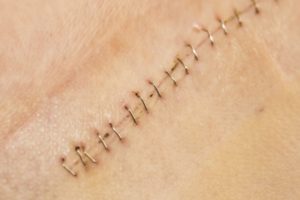How Do Surgical Wounds Close?
 One question patients often have after surgery is: how will my surgical wound close? There are three ways this can happen. Surgical wound closure can occur by primary, secondary, or tertiary intention.
One question patients often have after surgery is: how will my surgical wound close? There are three ways this can happen. Surgical wound closure can occur by primary, secondary, or tertiary intention.
What is Primary Intention?
Wound closure by primary intention is where the edges of a surgical wound are sutured, stapled, or glued to achieve closure. When the physician chooses to close an incision with primary intention, it’s because he or she has evaluated that there is no major loss of subcutaneous tissue, the edges are smooth, and the wound is not contaminated with microorganisms or foreign bodies. With this type of closure, the wound typically heals in a timely and predictable fashion with minimal tissue loss.
 What is Secondary Intention?
What is Secondary Intention?
Another means of closure is called secondary intention. This type of closure is often chosen when the wound demonstrates a large amount of skin or tissue loss in which the edges cannot be approximated, or there is a high microorganism count, debris, or tissue necrosis within the surgical wound area. With this type of wound, the wound environment is supported such that granulation tissue fills the area left open. Once filled with granulation tissue, the wound will contract and close and scar tissue formation occurs. Healing can be slow, which places the patient at risk for infection. Examples of wounds which may be healed by secondary intention include severe lacerations and trauma or massive surgical interventions.
What is Tertiary Intention?
Healing by tertiary intention (sometimes referred to as delayed primary intention) involves the intentional delay in closing a wound. In this type of surgical closure, the wound is left open, although stitches are placed in the subcutaneous and fascial layers. The remaining wound is left open and covered by a dressing to allow the infection or inflammation to subside. The wound is typically closed with staples or sutures in 5 to 7 days, after the risk of infection has significantly decreased or tissue tension has diminished.
Biologically, wounds heal similarly, but these surgical wound closure techniques are chosen by the physician with each individual patient in mind to achieve the most optimal healing based on the circumstances of the individual type of surgery, the patient’s health, the goal of care, and the condition of the wound.
To learn more about a product that can help in the management of surgical wounds, please visit https://sanaramedtech.com/surgical/celleraterx-surgical/




